Site Backups
This guide aims to help you set up automated site backups. Site backups are full backups of your site files and database.
Storage Settings
Before you can enable site backups, you must configure a cloud storage provider where your backup files will be stored. Navigate to the Backups tab under a site. From here add your storage provider or select from any previously configured storage provider options.

SpinupWP supports a number of cloud storage services. To quickly get started with your preferred storage provider, please follow one of the following guides:
Once you’ve created your provider, enter the bucket name and region where you would like backups to be stored. The bucket must already exist on your chosen storage provider before entering it on SpinupWP.
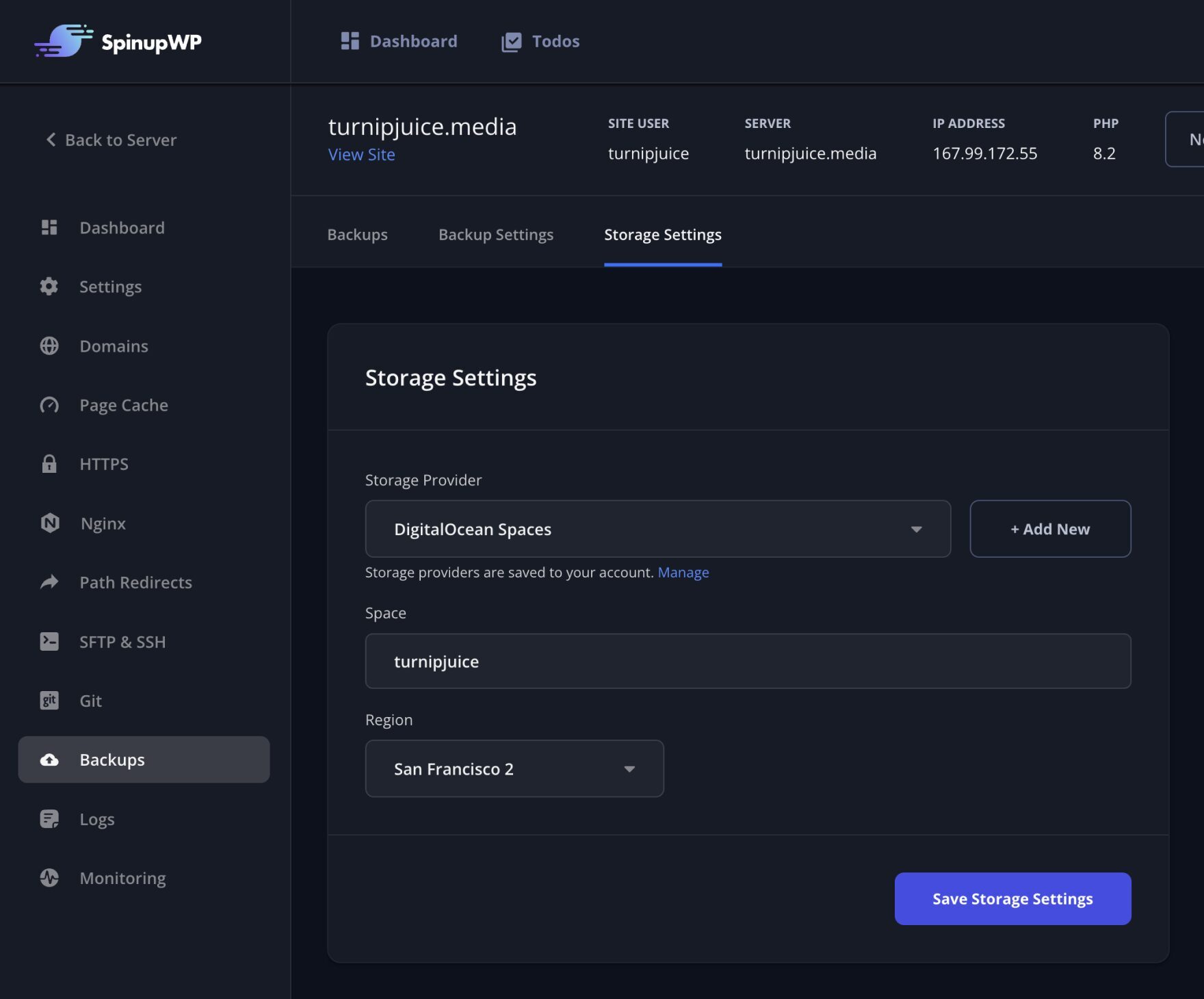
Backups are carried out in a rolling fashion. Meaning, that servers with multiple sites that have backups scheduled at the same time will only carry out one site backup at a time. This is to prevent overloading your server’s system resources.
What to Backup
What to Backup settings can be found under the Backup Settings tab.
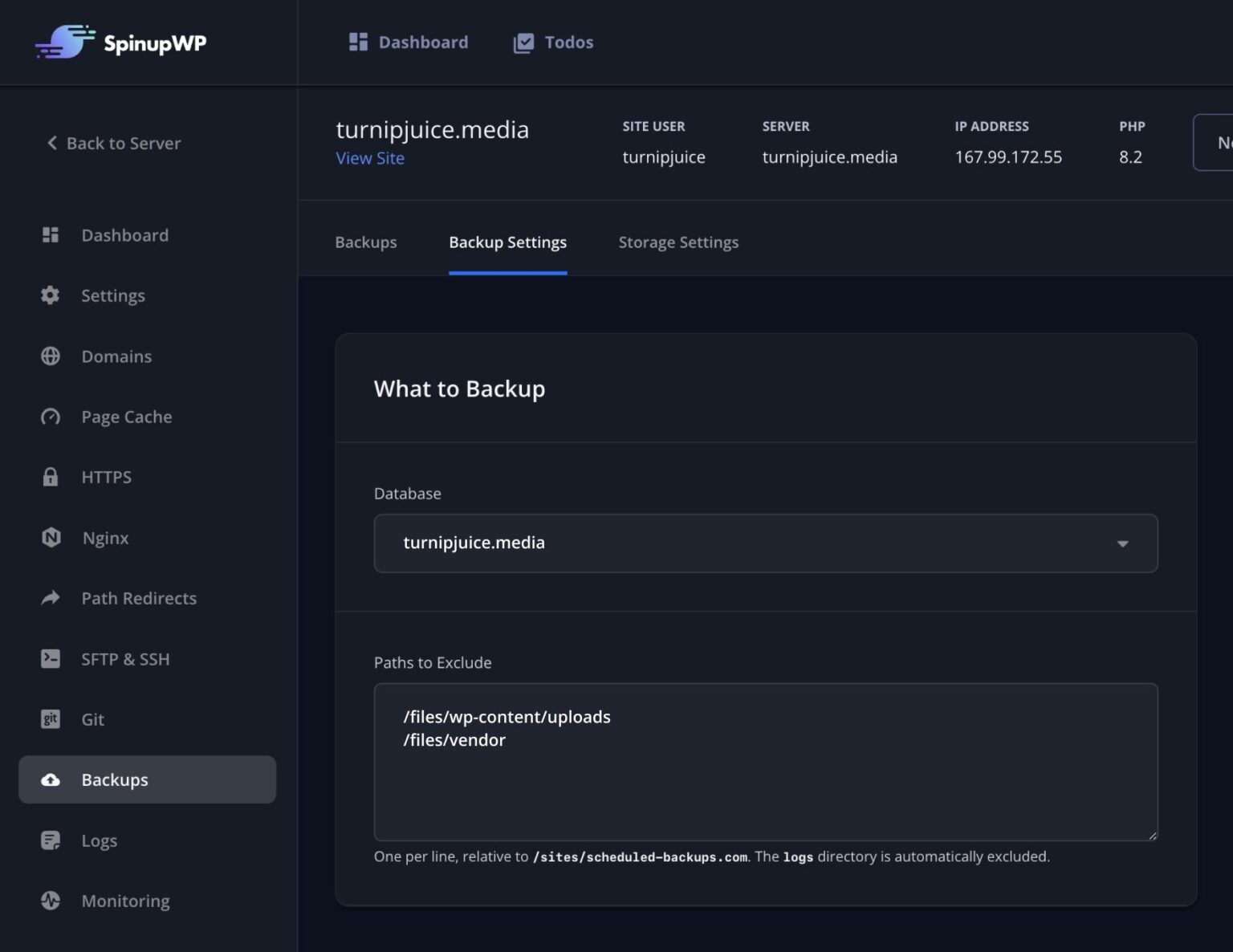
First, select the database to backup when backing up this site. Then if there are files or folders that you do not wish to include in your file backups. For example, if you’re using WP Offload Media to offload your Media Library to Amazon S3 and have versioning enabled on your bucket (a setup we highly recommend), there’s really no reason to include those files in your daily backups. In this case, excluding your uploads folder may make sense:
/files/wp-content/uploads
Similarly, if you’re using Composer to manage PHP dependencies, it’s likely that you don’t want to include the root vendor directory in your backups.
/files/vendor
It’s also possible to exclude certain file types. For example, MP4 video files:
*.mp4
Files Excluded from Backups By Default
The following paths are automatically excluded from all backups:
/sites/{DOMAIN}/.ansible
/sites/{DOMAIN}/.bash_history
/sites/{DOMAIN}/.bare_repo
/sites/{DOMAIN}/.bash_logout
/sites/{DOMAIN}/.bashrc
/sites/{DOMAIN}/.cache
/sites/{DOMAIN}/.cloud-locale-test.skip
/sites/{DOMAIN}/.composer
/sites/{DOMAIN}/.gnupg
/sites/{DOMAIN}/.local
/sites/{DOMAIN}/logs
/sites/{DOMAIN}/.profile
/sites/{DOMAIN}/.repo
/sites/{DOMAIN}/.selected_editor
/sites/{DOMAIN}/.spinupwp-pool.conf
/sites/{DOMAIN}/.ssh
/sites/{DOMAIN}/.wp-cli
Scheduled Backups
SpinupWP supports scheduling daily, weekly, and monthly backups for any site. Backup scheduling settings can be found under the Backup Settings tab. Depending on your billing plan, you may only have access to daily backups.
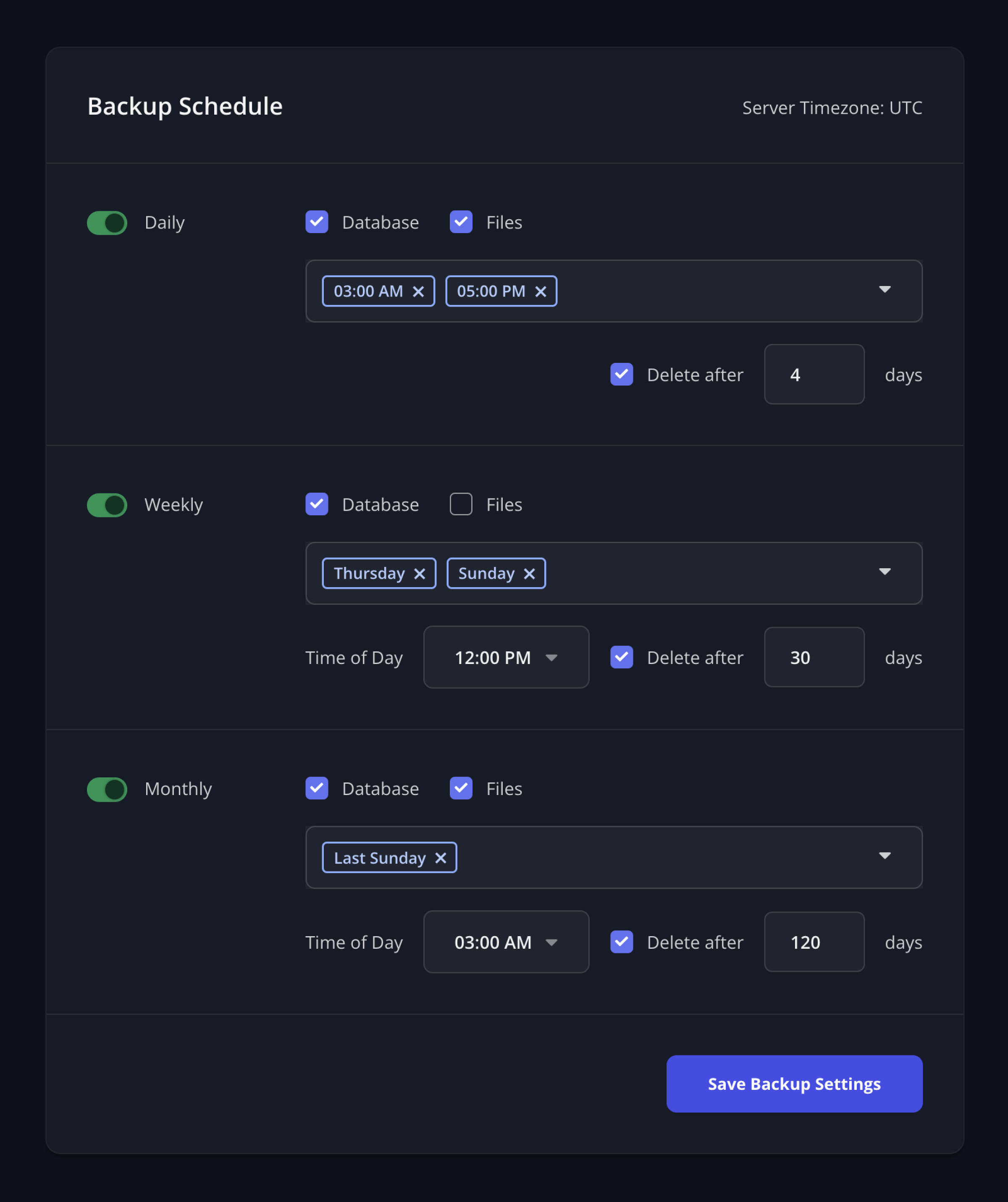
Much of the backup configuration options are the same across daily, weekly, and monthly.
For all scheduled backups, you can select to backup only files, to backup only the database, or to backup both files and the database.
With file backups selected, all files and folders within the site’s root folder (other than excluded files and folders) will be balled up into an archive file (tar) and compressed (gzip).
{BUCKET}/{DOMAIN}/{DATE}-files.tar.gz
With database backups selected, your database will be exported as an SQL file, gzipped, and saved to your storage provider in the following location:
{BUCKET}/{DOMAIN}/{DATE-DATABASE_NAME}.sql.gz
You may also enable the deletion of backups after a specified number of days. When this is enabled, SpinupWP will automatically delete backups from your storage provider based on their age.
For daily backups, you can select up to four times per day that backups are run.
When scheduling weekly backups, you can select up to four days of the week, as well as select the time of day you would like the backups to run.
For monthly backups, you’re able to select up to four options. These options include the first, second, third and last of each day of the week (e.g. First Sunday). As with weekly backups, you will also need to select the time of day you would like the backups to run.
If you configure backups for multiple sites on the same server to run on the same hour, they will run one after the other, not simultaneously. This is to prevent using up too much of your server resources and slowing down your sites.
You may wonder what happens when backup schedules overlap. For example, what if you have daily backups scheduled for 3:00 a.m. and weekly backups scheduled for Sundays at 3:00 a.m.? We’re proud to say that our backup system recognizes this overlap and only runs one backup on Sundays at 3:00 a.m. The Type column in the backup listing will show “Daily/Weekly” while the backup is serving as both a daily and weekly backup.
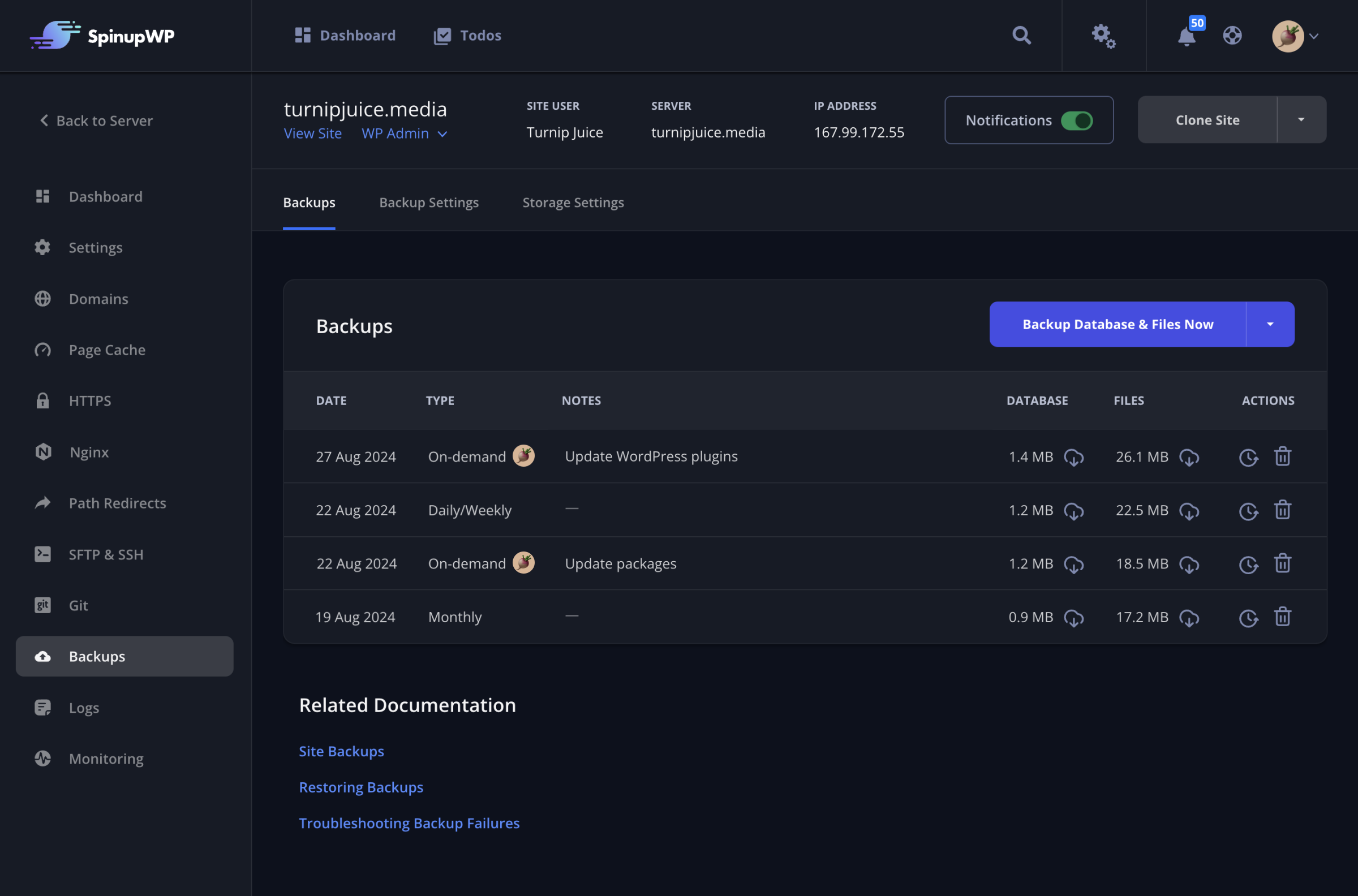
Now let’s say the daily backups are set to be deleted after 3 days while the weekly backups are set to be deleted after 14 days. The Sunday backup will show as “Daily/Weekly” for the first 3 days and will show as just “Weekly” thereafter until it is removed at the 14-day mark.
On-Demand Backup
There may be times when you wish to trigger a backup instantly. This is useful if you’re making changes to your site and wish to take a snapshot before deploying any changes. You can perform an on-demand backup at any time. Navigate to the backups tab on the site screen and click Backup Database & Files Now. Alternatively, you could select to backup only the database or only the files from the button dropdown.
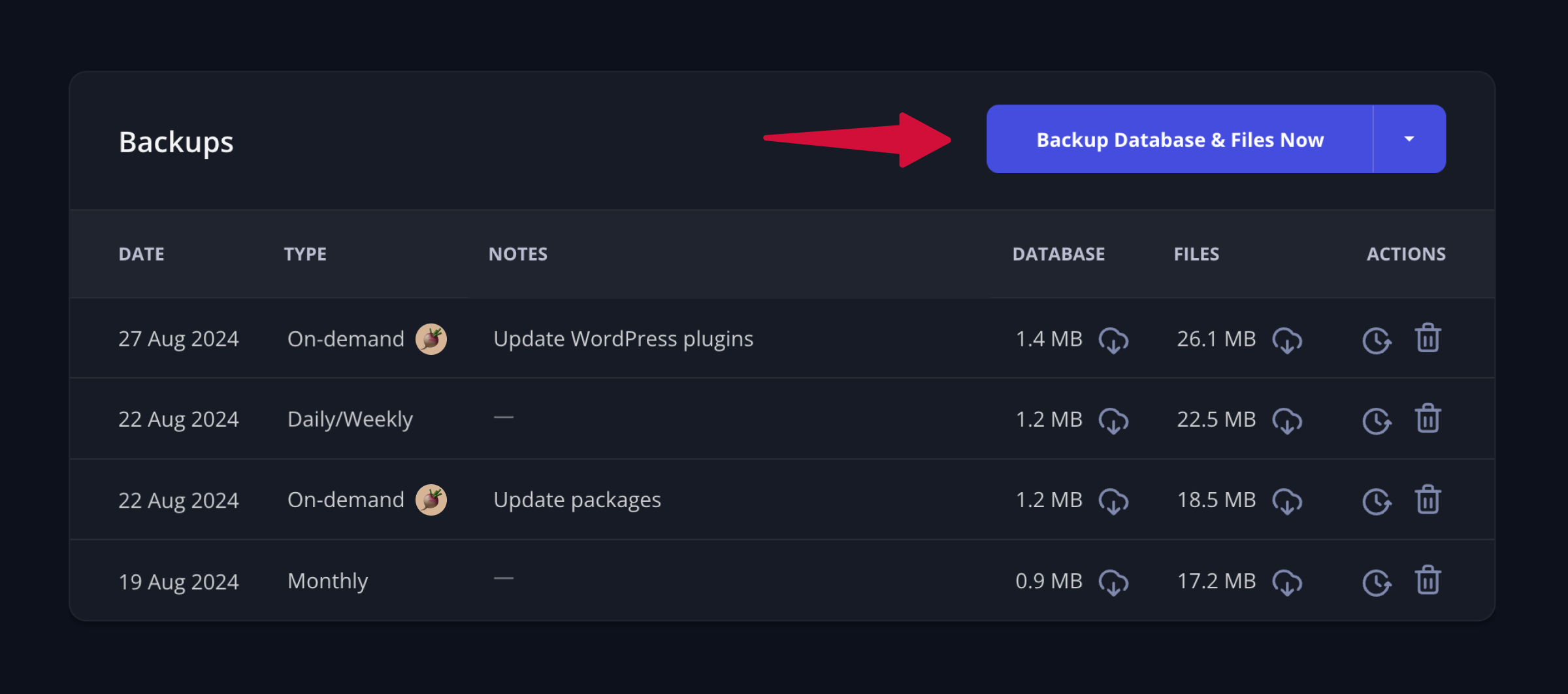
Backup Listing
The backup listing is retrieved from your storage provider each time you load the backups screen, so you can be sure it is an up-to-date, accurate listing of your backups. It displays the date and time, who initiated the backup, the backup schedule or schedules responsible for the backup, the size of the site files backup, and the size of the database backup.
You can also easily distinguish a site backup by adding a note to it. To add a note, click in the “Notes” column of a backup in the backups table. If there’s already a note, you can edit it by clicking on it. If you choose to create a backup when restoring a database, a note of “Prior to restoring backup from {{ date of backup being restored }}” will be added to the backup automatically. Similarly, if you choose to create a backup when updating WordPress core, plugins, and/or themes, a note of “Prior to updating WordPress core, themes, and plugins” will be added automatically. You can edit these notes as you like.
Click on the icons in the Database, File and Actions columns to download the database backup, download the site files backup, restore the site backup to the original site or delete the backup.
Full Server Backups
SpinupWP doesn’t provide full server backups or snapshots (as they’re also known). We believe that these types of backups are best performed by your server provider (Vultr, AWS, etc). Full server backups can be enabled when provisioning a new server in SpinupWP (for supported providers). Alternatively, they can be enabled via your server provider’s control panel at any time.
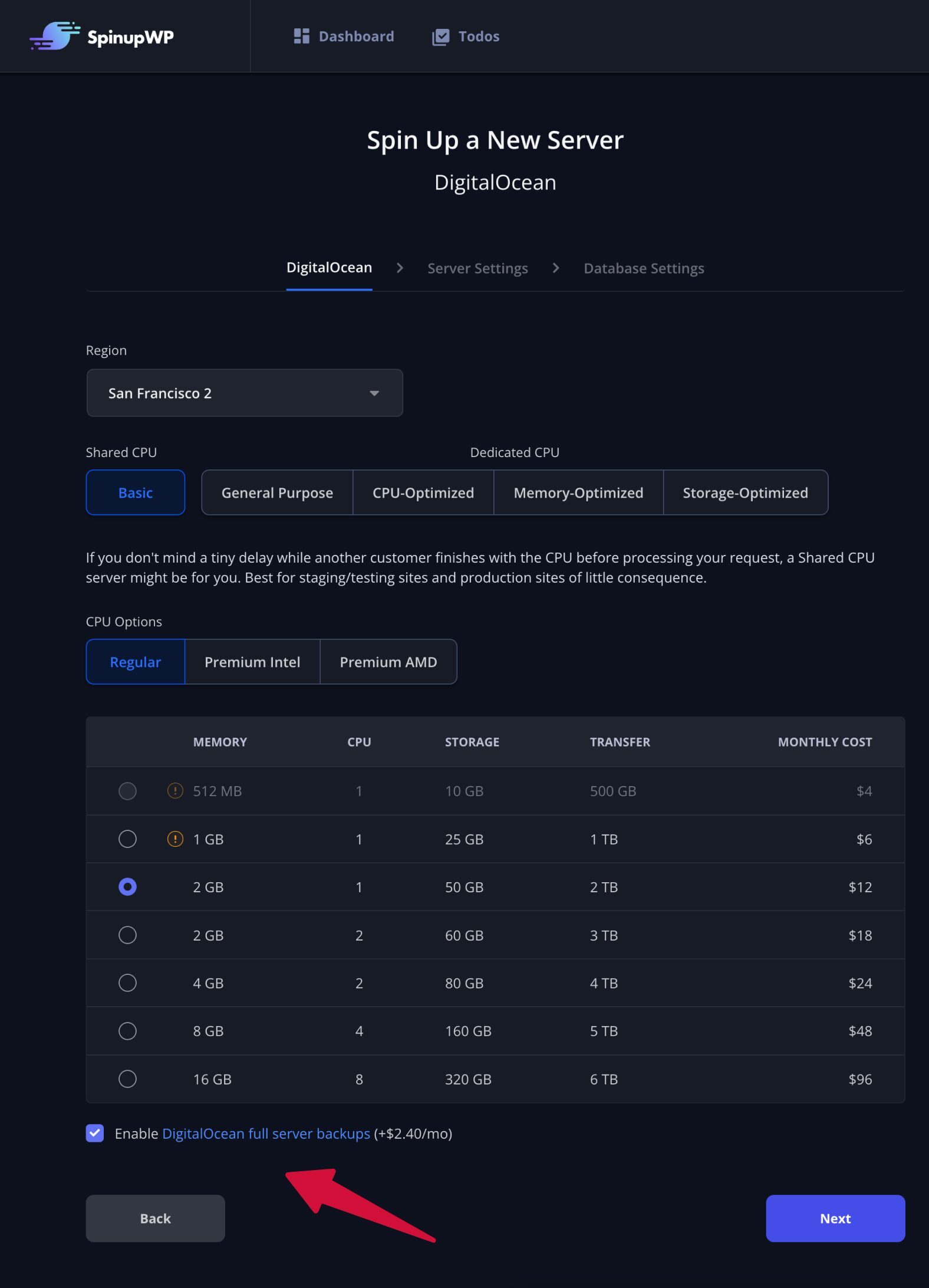
For more information see our doc Restoring a Full Server Backup and Updating the SpinupWP Dashboard.
Manage Storage Providers
Storage providers are attached to your account. You can add, edit or delete storage providers from your Account Settings.

Troubleshooting Backup Failures
If you run into issues with site backups, please see our Troubleshooting Backup Failures doc.